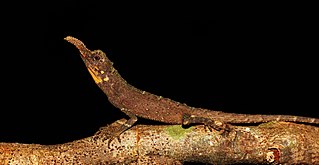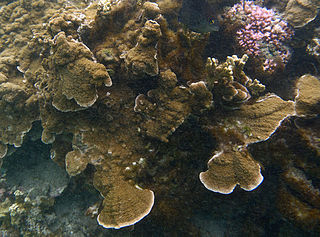
The Asian giant toad, sometimes referred to as the river toad, is a species of true toad native to Mainland Southeast Asia and the Greater Sundas. It is a medium-large toad, but it is easily confused with its larger relative, the giant river toad.
Ormocarpopsis is a genus of flowering plants in the family Fabaceae, and was recently assigned to the informal monophyletic Dalbergia clade of the Dalbergieae. It contains the following species:
Ormocarpopsis calcicola is a species of flowering plant in the family Fabaceae. It is found only in Madagascar.
Ormocarpopsis itremoensis is a species of flowering plant in the family Fabaceae. It is found only in Madagascar.
Ormocarpopsis mandrarensis is a species of flowering plant in the family Fabaceae. It is found only in Madagascar.
Ormocarpopsis parvifolia is a species of flowering plant in the family Fabaceae. It is found only in Madagascar.
Ormocarpopsis tulearensis is a species of flowering plant in the family Fabaceae. It is found only in Madagascar.
Scalesia aspera is a species of flowering plant in the family Asteraceae. It is found only in the Galapagos Islands of Ecuador. It is threatened by habitat loss.

Hylomantis aspera is a species of frog in the family Phyllomedusidae. It is endemic to Brazil. Its natural habitats are subtropical or tropical moist lowland forests, swamps, and intermittent freshwater marshes. It is threatened by habitat loss.
The Derby toadlet is a species of frog in the family Myobatrachidae. It is endemic to the Kimberley region near Derby and Broome in Western Australia. Its natural habitats are subtropical or tropical dry lowland grassland and intermittent freshwater marshes.
Pipa aspera, the Albina Surinam toad, is a species of frog in the family Pipidae found in French Guiana, Suriname, and possibly Brazil. Its natural habitats are subtropical or tropical moist lowland forests, rivers, freshwater marshes, and intermittent freshwater marshes. The color of this species is a reddish-brown to a brownish-black, noticed on the dorsal part of its body. The weights of females range between 5 and 12 grams, and males between 4 and 7 grams, noting that females are usually significantly larger.
Protium asperum is a species of plant in the Burseraceae family. It is found in Colombia, Costa Rica, Ecuador, Panama, Peru, and possibly Bolivia.

Acanthemblemaria aspera, the roughhead blenny is a species of blenny native to the tropical western Atlantic Ocean. Typical length is 19 mm (0.75 in) for adult males and 21 mm (0.83 in) for females.

The rough-nosed horned lizard or Sri Lanka horned agama is an Agamid lizard from Sri Lanka in lowland dipterocarp forests and secondary forests in the wet zone. It is distinguished from all the other Ceratophora species by the presence of a complex rostral appendage, comprising more scales than rostral scale alone. The lateral body scales are small and more or less regular shape.

Candoia aspera, known commonly as the viper boa, Papuan ground boa, or New Guinea ground boa, is a species of snake in the family Boidae. As its common name suggests, it is found in New Guinea. They are a terrestrial species, living in the undergrowth. They are smaller than some other members of the Boidae family. Viper boas grow to 2 to 3 feet in length. They are known to be primarily nocturnal. Viper boas are known to be slightly more aggressive than other Candoia. In recent years they've become increasingly scarce in the pet industry, due to restrictions on import/export trading. Though they were more common in the past, there is still very little known about them, in particular their behaviour in the wild. For example; Their lifespan is still undetermined. It got the nickname viper boa from its appearance. They look extremely similar to the elapid species Acanthophis laevis, more commonly known as the "Papuan death adder." The death adder itself only resembles a viper, but is actually an elapid. However, because of the resemblance to the highly venomous death adder, many are killed out of fear although they are harmless.

Acropora aspera is a species of staghorn coral in the family Acroporidae. It is found on reef flats and in lagoons in very shallow water in the western Indo-Pacific Ocean.

Coelastrea aspera is a species of stony coral in the family Merulinidae. It is a colonial species native to the Indo-Pacific region where it occurs in shallow water. It was first described by the American zoologist Addison Emery Verrill in 1866 as Goniastrea aspera but it has since been determined that it should be in a different genus and its scientific name has been changed to Coelastrea aspera. This is a common species throughout much of its wide range and the International Union for Conservation of Nature has rated its conservation status as being of "least concern".

Echinophyllia aspera, commonly known as the chalice coral, is a species of large polyp stony corals in the family Lobophylliidae. It is a colonial coral which is partly encrusting and partly forms laminate plates or tiers. It is native to the western and central Indo-Pacific.

Ephedra coryi, also known as Cory's joint-fir, is a rare, reed-like gymnosperm native to sandy, semi-arid areas of the North American South and Southwest.

Protea aspera, commonly known as rough leaf sugar bush or aardroos suikerbos, is a flowering shrub that belongs to the well-known Protea genus. The plant is endemic to South Africa and is found at Kleinrivierberg, Bredasdorpberg and Garcia's Pass.










